Origin Genesis Review: Triple Titan Terror
by Ryan Smith on April 23, 2013 9:00 AM ESTLetting Titan Spread Its Wings, Cont
Moving on, let’s take a look at 3 of our most intensive games: Battlefield 3, Far Cry 3, and Crysis 3.

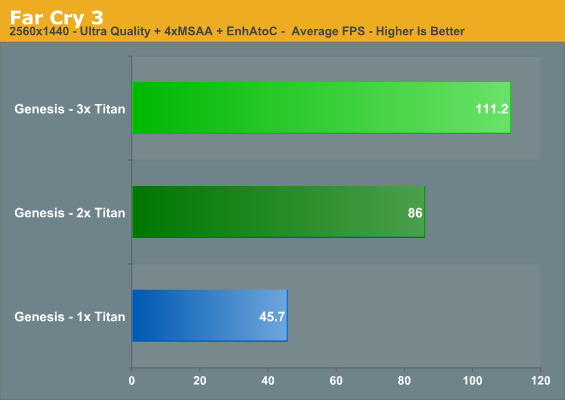
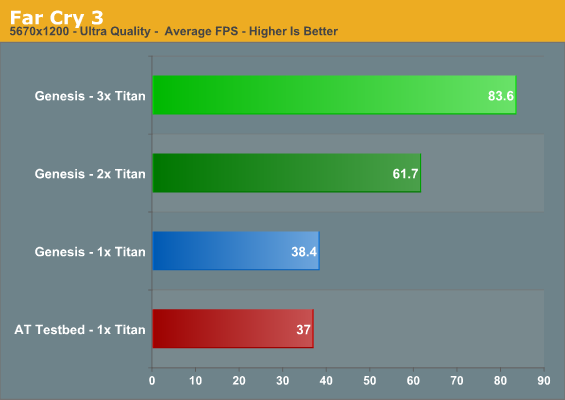
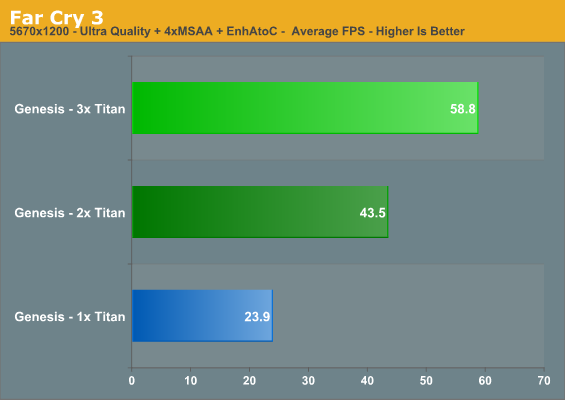
Far Cry 3 is another game that highlights the difficulty in keeping all 3 Titans fed. We have to go to 5760 before a tri-SLI setup isn’t being held back by the CPU. Once we’re there however, additional Titans make a clear difference. At least 2 are required to keep average framerates above 60fps at 5760 without anti-aliasing, and with the AA cranked up even 3 Titans can’t quite crack 60fps. This may be for the best though; for some reason the input lag at 5760 with 3 Titans is especially bad, and this is likely a further artifact of Far Cry 3’s quirks.
At the very least scaling is once again fairly good. At 5760 with AA moving from 1 to 2 Titans improves performance by 82%, and 2 to 3 Titans by another 35%.
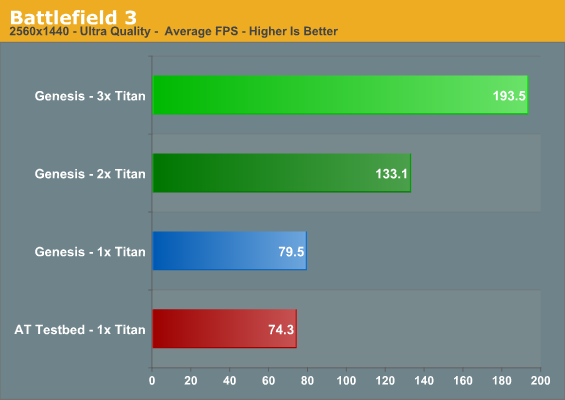
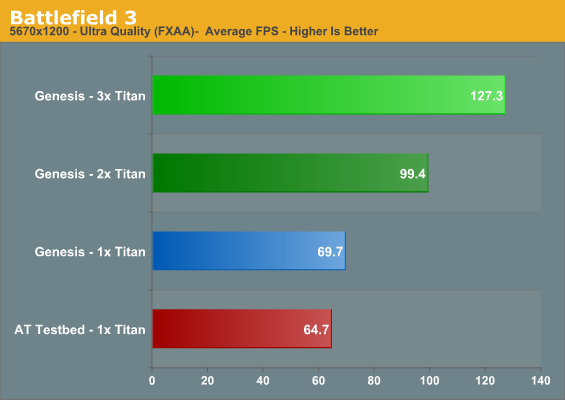
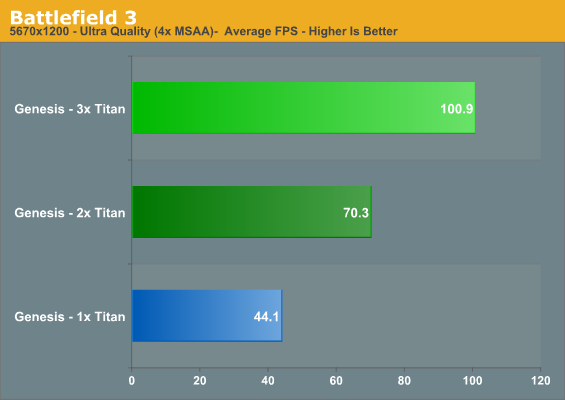
Battlefield 3 isn’t appreciable CPU limited, but it does present something of a scaling issue for Titan. Scaling with 1 display is only 67% for the 2nd Titan, and 45% for the 3rd. And with multiple displays at 5760 with MSAA that becomes 59% and 43% respectively. Oddities aside of scaling being relatively better with the 3rd Titan than the 2nd, even with MSAA we’re seeing an average of 70fps with 2 Titans at 5760, so minimum framerates are still above 30fps. So the practical advantage of the 3rd Titan is limited to minimum framerates, or otherwise doing 120Hz gaming.
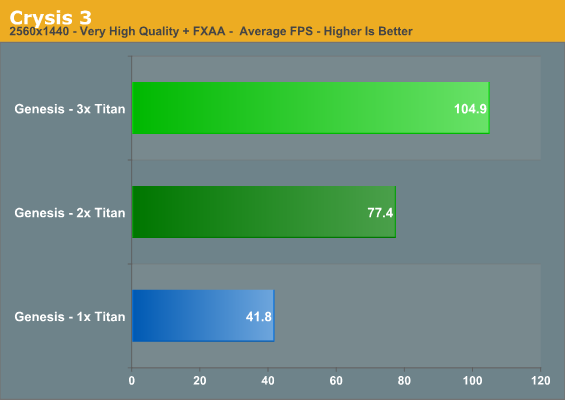
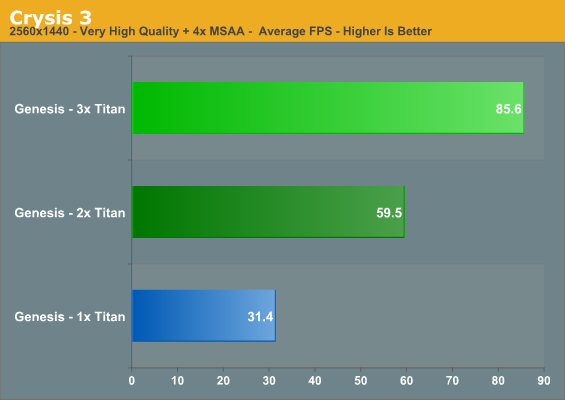
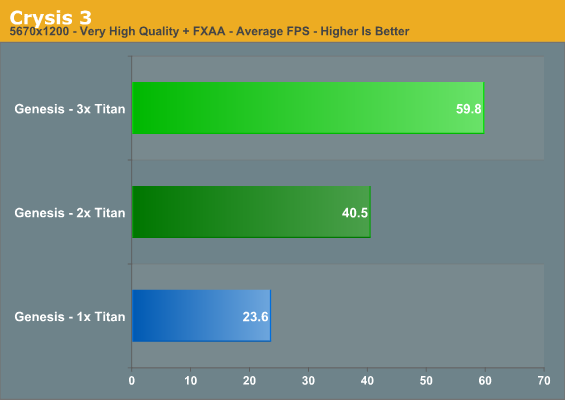
Finally we have Crysis 3, which is first being used here before rolling it into our larger benchmark suite. Taken from the intro level (Post-Human), Crysis 3 was meant to kill GPUs and it shows. 1 Titan can’t break 60fps at 2560 even with FXAA, and 2 Titans are just short if we add MSAA. Move to 5760, and even 3 Titans won’t break 60fps with FXAA. So while the rest of the games in our suite need multi-monitor resolutions to really take advantage of a tri-SLI setup, even 1 2560 monitor can drag a tri-SLI setup back down to earth when it comes to Crysis 3. Even if it’s not game of the year, just as in past years Crysis 3 will move high-end video cards; of that there’s no doubt.
Looking at Titan scaling again, Crytek and NVIDIA have clearly done their homework for single-monitor resolutions. At 2560 with MSAA scaling is 89% from 1 card to 2, and 44% from 2 cards to 3. Unsurprisingly, scaling does taper off at 5760 due to the performance hit of keeping multiple display buffers across multiple cards organized. 1 card to 2 cards is just 72% here, but adding a 3rd card adds another 47% in performance.
Across our 6 games we can see that 3 Titans generally pays off, but a big part of this is using resolutions and settings that can shift as much of the burden onto the GPU as possible. With the exception of Crysis 3 almost everything plays fine on just 2 Titans, with the 3rd Titan necessary to hit 5760x1200 with the best quality settings. On the other hand the fact that even Crysis 3 is almost at 60fps at 5760 with everything short of MSAA turned up is quite a change of pace. NVIDIA told us they wanted tri-SLI Titan to be a no-compromise gaming setup, and indeed they’ve delivered on that.
The only way we’d be able to push a tri-SLI Titan setup harder would either be to use a 2560x1440 surround setup – which admittedly isn’t outside the realm of possibility when we’re talking about pairing it with a $9000 computer – or otherwise going outside the lines and using SSAA on the titles that support it. It may come off as hyperbole, but “I have 3 monitors and the Genesis still isn’t slow enough” was a very real problem putting this article together. To that end it’s surprising that we weren’t CPU limited more often than we were; it’s still a concern, but for the most part in surround gaming the CPU can stay ahead of the GPU, at least if it’s as heavily overclocked as the Genesis’ 4.9GHz SNB-E.










63 Comments
View All Comments
DanNeely - Tuesday, April 23, 2013 - link
I'd swag it at 3-4 years for a $1200 box; and two more for the $600 pricepoint.We're probably 2 die shrinks from having similar performance levels in an x70/x80 card. The first shrink will put slightly better than titan level performance down the upper mainstream die size (assuming standard doubling); the second will give a single card with double that and since 3way SLI performance is significantly less than the 3x that linear scaling assumes the 2 die shrink GPU should be in the same ballpark.
That's only 3 years out. Depending on how competitive the market is that card could be anywhere between $250 and $600ish; the lower end of that range should easily make a $1200 system; the top of it will probably be a year behind with the $600 price point needing another die shrink so 2 more years for that or 6 total.
faroguy - Tuesday, April 23, 2013 - link
NVIDIA had a demo system at GTC with 3 Titan's in it that was running Metro: Last Light. It was quite an awesome feeling to play on a system with that much power. Also, it wasn't terribly loud.Samus - Tuesday, April 23, 2013 - link
lol, ridiculous BF3 scorekrazeyivan - Tuesday, April 23, 2013 - link
If you want to see a beast system with 4 x Titans - check this link - probably the fastest 24/7 Rig aroundhttp://hardforum.com/showthread.php?t=1755071
Denithor - Tuesday, April 23, 2013 - link
Well, now that you have enough GPU power to push those games, do some core count studies and see what games are seriously benefiting from 2/4/6 cores. This would clearly show where you're being held back by CPU versus GPU.DanNeely - Tuesday, April 23, 2013 - link
Very few games are heavily threaded on the CPU today; so finding CPU bottlenecks would be about downclocking the chip not disabling cores. With the PS4 and xbox720 rumored to have 8 relatively lightweight CPU cores we probably will start seeing games able to take better advantage of the width of high end CPUs in a few years; but we're not at that point today.mapesdhs - Tuesday, April 23, 2013 - link
Ryan writes:> 1340W at the wall is over 11 amps; we’re not to the point where the Genesis
> needs a dedicated circuit, but that’s the majority of a 15 amp circuit right there.
Less than 6A where I am. ;)
Finally Edison's daft low-voltage DC-bias legacy is revealing itself. Is it possible that top-end
PC tech development may eventually become limited by the comparatively low max power
available from a US wall socket? I hope not.
Ian.
Death666Angel - Tuesday, April 23, 2013 - link
"Is it possible that top-end PC tech development may eventually become limited by the comparatively low max power available from a US wall socket? I hope not."Nope. You already have household items that use power in the thousand Watt range (vacuums, heaters, microwaves etc.), so a PC doing the same thing isn't a problem. And the drive in the PC industry is for lower power consumption overall. No one of the component vendors is pursuing 1k+ Watt PCs. It's the end manufacturers that offer that kind of power consumption beast on their own. And the few people that really need bigger PCs usually have their own circuits to run them off, along with specialized cooling solutions.
Death666Angel - Tuesday, April 23, 2013 - link
I don't understand the choice of 2 120GB SDDs (in RAID 0 nonetheless). And 4x4GB RAM looks wrong in this type of PC. If you go crazy, go crazy on everything. :DAs for the water cooling, I'd rather have another case that supports something like 200/280/360/420 radiators and at least 2 of those. This setup is not very elegant. If you go with such a case, give me an external water cooling radiator like the 1080/1260 ones or install a 480 quad one on the side of the case.
hero1 - Tuesday, April 23, 2013 - link
With that much money spent on the hardware I would expect them to have used a better case, custom one and bigger radiators to reduce the heat and noise. Poor job imo.